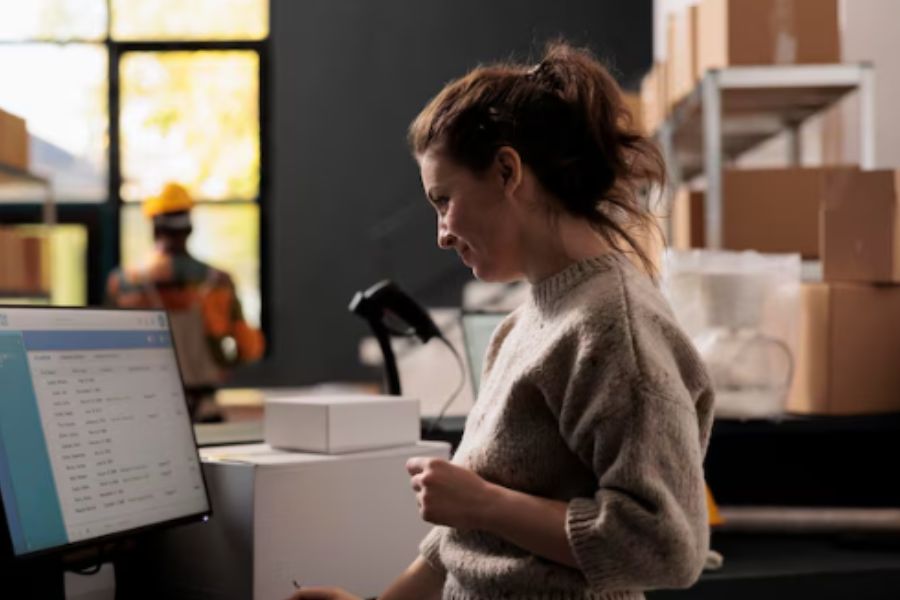In the highly competitive world of fashion retail, staying ahead means more than offering stylish collections—it demands speed, operational efficiency, and an exceptional customer experience. Zara, one of the world’s most successful fast fashion brands, has mastered this formula by leveraging a powerful apparel POS (Point of Sale) system that fuels its retail innovation.
By integrating advanced POS technology across its supply chain and storefronts, Zara has streamlined everything from real-time inventory management to seamless in-store and online transactions. This article explores how Zara’s intelligent POS system contributes to its global dominance and reveals valuable lessons fashion retailers can adopt to scale efficiently, improve customer satisfaction, and stay ahead of trends.
Zara’s Competitive Edge in the Fashion Market
Zara, a global fashion retailer based in Spain, has cemented its position as a trendsetter in the fast-fashion industry. With over 2,000 stores worldwide and a strong online presence, Zara has become synonymous with accessible luxury and rapid turnover of fashion trends. One of the key factors contributing to Zara’s success is its ability to quickly adapt to changing consumer preferences and deliver high-quality, on-trend apparel at affordable prices. The brand introduces new designs multiple times a week, keeping its offerings fresh and aligned with evolving fashion trends.
Zara’s unique business model revolves around its vertically integrated supply chain. Instead of outsourcing production, the company designs, manufactures, and distributes its clothing in-house. This structure enables faster product development and minimizes reliance on external suppliers. With real-time inventory tracking powered by its apparel point of sale system, Zara can adjust production based on buying patterns, reducing excess stock and ensuring popular items stay available.
Zara’s store locations and layouts also contribute to its success. The brand prioritizes high-traffic areas in major cities, attracting a diverse customer base, from fashion enthusiasts to casual shoppers. Its minimalist, modern store designs focus attention on the clothing, creating a seamless shopping experience. In addition, Zara’s POS system integrates online and in-store sales, giving customers real-time stock availability and flexible purchasing options.
Not only logistics, data-driven decision-making plays a central role in Zara’s strategy. The company leverages artificial intelligence and advanced analytics to understand customer behavior and predict demand. By analyzing sales data from its apparel POS system, Zara refines its product selection and marketing efforts, tailoring collections to customer preferences. This approach keeps the brand relevant while maximizing sales potential.
Zara’s ability to merge technology with fashion retail has set a new industry standard. By using an intelligent apparel point of sale system, the company maintains a competitive edge, responding to consumer trends with unmatched speed and efficiency.
How Zara Uses an Apparel Point of Sale System to Stay Competitive
In the fast-moving world of fashion retail, speed, efficiency, and customer experience are critical to staying ahead. Zara, one of the most successful fast fashion brands, has built a highly efficient business model that allows it to bring new styles to market faster than competitors. A key part of this success lies in its advanced Apparel Point of Sale (POS) system, which integrates technology, data, and logistics to streamline operations.
Omnichannel Management in a Unified System
Seamless Integration Across Multiple Sales Channels
Zara operates across physical stores, online platforms, and mobile applications, requiring a seamless connection between all sales channels. Its apparel POS system keeps inventory and pricing synchronized, preventing discrepancies between in-store and online availability. Customers can check product availability, switch between channels effortlessly, and choose flexible fulfillment options like click-and-collect or home delivery.
Store placement also plays a role in Zara’s omnichannel strategy. Locations in high-traffic areas help drive footfall, while the POS system connects these stores to Zara’s digital ecosystem. This ensures that customers receive the same pricing, promotions, and product details whether they shop online or in person.
Similarly, ConnectPOS offers an apparel POS system designed to unify retail operations. It provides a single dashboard for managing sales, inventory, and customer data across all channels. Features like real-time synchronization of product details, pricing, and promotions keep the shopping experience smooth, while options such as click-and-collect and ship-from-store give customers greater flexibility.
Real-Time Inventory Management Across Locations
Zara’s ability to maintain stock accuracy across its global operations relies on real-time inventory tracking. The apparel POS system continuously updates stock levels, preventing overselling and helping stores reallocate inventory when needed. If an item sells out in one location, sales associates can quickly check availability in nearby stores or suggest online ordering options.
This system also supports faster restocking. Instead of relying on long production cycles, Zara can identify high-demand items and adjust inventory allocation immediately. This agility reduces the risk of stock shortages while minimizing unsold inventory.
Retailers using ConnectPOS gain similar advantages. The system integrates with supply chain management tools, keeping stock data updated across all locations. Businesses can track product movements, prevent stockouts, and streamline restocking efforts.
Flexibility to Adapt to Market Trends
Responding Quickly to Consumer Demand
Zara thrives in fast-changing fashion cycles, where demand shifts rapidly. Its POS system collects sales data in real time, helping the company detect emerging trends and adjust product offerings accordingly. If a particular style gains popularity, Zara can speed up production and distribution, keeping pace with customer demand.
Scalability for Evolving Retail Needs
Beyond product trends, the system helps Zara adjust pricing, promotions, and store displays based on real-time insights. Discounts on slow-moving items can be applied instantly, while high-demand products are strategically restocked. This flexibility allows Zara to stay ahead of competitors who rely on longer production timelines.
Data-Driven Strategies for Smarter Retail Decisions
Leveraging Sales Data for Better Forecasting
Zara’s POS system serves as a data powerhouse that guides business decisions. By analyzing customer preferences, sales patterns, and demand forecasts, Zara refines its pricing strategies, store layouts, and inventory planning.
For example, if certain products sell faster in specific regions, Zara can customize stock allocation to match local demand. Similarly, insights into customer shopping habits help the brand personalize promotions and product recommendations.
Retailers using ConnectPOS benefit from similar data-driven insights. The system tracks sales trends, inventory turnover, and customer behavior, helping businesses make informed decisions that drive profitability.
Key Features That Strengthen Zara’s POS Strategy
Creating multiple variants for products to enhance categorization and sales
Zara’s apparel point-of-sale (POS) system allows the company to create multiple product variants, including different sizes, colors, and styles. This feature helps Zara effectively categorize its extensive range of products, making it easier for customers to find what they are looking for. With a diverse selection of variants, Zara can cater to a wide variety of preferences and tastes, which enhances sales opportunities. For instance, customers searching for a specific item can quickly locate it in their desired size and color, resulting in higher conversion rates and greater customer satisfaction.r satisfaction.
Implementing personalization based on client information and past purchase history
Zara’s apparel POS system features advanced personalization capabilities that allow the company to customize the shopping experience for each individual customer. By capturing and analyzing customer information and past purchase history, Zara can offer personalized recommendations and promotions tailored to each shopper. For example, if a customer frequently buys dresses in a particular style or color, Zara can send targeted promotions or alerts for similar items, which increases the chances of repeat purchases. This personalized approach not only enhances customer engagement and loyalty but also drives revenue growth by encouraging upselling and cross-selling.
Supporting multiple payment methods for customer convenience
Zara’s apparel POS system offers seamless integration with multiple payment methods, including credit cards, mobile wallets, and contactless payments. This flexibility reduces checkout delays and improves customer satisfaction, making transactions faster and more convenient.
Zara’s POS Strategy Strengthens Its Business & Solves Key Challenges
Smarter Inventory Management with Real-Time Tracking
Zara’s apparel point of sale system provides real-time inventory updates, allowing the company to track stock levels, product availability, and sales performance across all locations. This visibility helps Zara allocate inventory efficiently, preventing stock shortages and reducing excess stock. If a particular item sells out quickly in one region, the system identifies the demand spike, and Zara can adjust production or redistribute stock accordingly.
Zara’s fast supply chain and POS integration allow for continuous stock adjustments. This flexibility reduces waste, lowers storage costs, and keeps stores stocked with high-demand products.
A More Personalized & Convenient Shopping Experience
Zara’s POS system improves the shopping experience by offering tailored product suggestions, faster checkouts, and multiple payment options. It tracks customer preferences and purchase history, allowing Zara to recommend products that match individual shopping habits. If a customer frequently buys a certain style, the system can highlight similar items, increasing engagement and repeat purchases.
Checkout speed is another advantage. Zara has mobile POS terminals and self-checkout options, helping customers complete purchases quickly. The system also supports various payment methods, making transactions smoother and more convenient.
This focus on efficiency and personalization encourages customer loyalty and strengthens Zara’s brand identity.
Faster Response to Market Trends
Zara’s POS system helps the company react quickly to shifting fashion trends. The system collects real-time sales data, making it easier to identify popular styles and adjust production accordingly. If a specific item starts selling faster than expected, Zara can increase production within weeks, avoiding missed sales opportunities.
Not only product demand, the system enables Zara to adjust prices and promotions instantly. Slower-selling items can receive discounts right away, while the most popular designs maintain strong pricing strategies. This ability to adapt pricing and stock levels in real time gives Zara a major advantage over competitors with slower supply chains.
Smarter Business Decisions with Data-Driven Insights
Zara’s POS system helps the company react quickly to fashion trends. The system collects real-time sales data, making it easier to spot rising demand and adjust production accordingly. If a style suddenly gains popularity, Zara can increase production within weeks, reducing missed sales.
Furthermore, the system helps Zara modify pricing and promotions instantly. Slower-selling items receive immediate discounts, while top-selling styles maintain strong pricing. This flexibility keeps Zara ahead of competitors with longer production cycles.
Stronger Business Decisions Through Data Insights
Zara’s POS system functions as a key decision-making tool. With collected data and deeper insights, the company fine-tunes pricing, inventory planning, and store layouts based on real-world data.
For example, Zara adjusts product placement in stores, ensuring high-demand items remain easily accessible. The system also helps with staff scheduling, matching employee shifts with peak shopping hours. These insights reduce inefficiencies and improve overall store performance.
ConnectPOS – Powerful Apparel POS for Fashion Retailers
As seen with Zara, an advanced point-of-sale (POS) system can drive strong results in the fashion retail industry. While Zara developed its own system, other retailers can achieve similar advantages with ConnectPOS. This system helps businesses stay on top of inventory, checkout speed, and multi-channel sales without the need for custom-built software.
Key features include:
- Real-time stock tracking – Keeps inventory updated across all stores and online platforms.
- Mobile POS support – Lets staff process sales anywhere in the store, reducing checkout lines.
- Custom promotions – Applies discounts and special offers automatically at checkout.
- Omnichannel integration – Syncs online and offline sales for a consistent shopping experience.
- Flexible payment options – Supports multiple payment methods, including digital wallets.
Fashion retailers need a fast and reliable POS system to keep up with shifting trends. ConnectPOS helps businesses stay organized, simplify sales, and create a smoother shopping experience.
FAQs: How Zara Dominates Fashion with a Smart Apparel Point-of-sale System Strategy
1. How does the smart POS system impact Zara’s business processes?
Zara’s smart apparel point of sale system significantly streamlines its business processes by enhancing efficiency, accuracy, and agility. The system enables seamless integration between sales, inventory management, and customer data, allowing for real-time insights and informed decision-making. By automating various tasks and optimizing workflows, Zara can better manage its operations, improve inventory turnover, and enhance the overall customer experience.
2. What challenges does the apparel point of sale system help Zara address in the fashion industry?
Zara’s POS system helps address several challenges prevalent in the fashion industry. These challenges include effectively managing inventory across multiple locations, adapting to rapidly changing consumer preferences and market trends, optimizing pricing strategies, and maintaining seamless omnichannel integration. By leveraging a robust POS system, Zara can overcome these obstacles and remain competitive in the fast-paced fashion landscape.
3. How does Zara maintain and update its system to align with new trends?
Zara continuously invests in maintaining and updating its POS system to align with new trends and technological advancements in the fashion industry. The brand closely monitors emerging trends, consumer behavior, and technological innovations to inform its system updates. Additionally, Zara collaborates with industry partners and leverages customer feedback to identify areas for improvement and implement new features that enhance the system’s functionality and relevance.
4. What benefits do Zara’s customers derive from this smart point-of-sale system?
Zara’s customers benefit from its smart POS system in various ways. The system enables faster checkout processes, personalized recommendations based on past purchases, seamless online and offline shopping experiences, and convenient payment options. By leveraging data-driven insights, Zara can better understand its customers’ preferences and tailor its offerings to meet their needs, ultimately enhancing customer satisfaction and loyalty.
5. How does the apparel point of sale system influence Zara’s marketing strategy?
Zara’s POS plays a crucial role in shaping its marketing strategy by providing valuable data and insights into consumer behavior, sales trends, and product performance. The system enables targeted marketing campaigns, product promotions, and pricing strategies based on real-time market data. Additionally, by integrating with customer relationship management (CRM POS) tools, Zara can personalize marketing communications and enhance customer engagement, ultimately driving sales and brand loyalty.
Conclusion
Zara’s dominance in fashion retail comes from a strategic approach combined with a powerful apparel point of sale system. With the idea of aligning inventory management, pricing, and customer engagement with real-time data, the brand can respond quickly to trends, keep stock levels precise, and create a seamless shopping experience. While technology supports these operations, it’s Zara’s business model that drives its ability to stay ahead in a competitive market.
A strong POS system helps fashion retailers manage inventory efficiently, speed up transactions, and connect in-store and online sales without disruptions. If you’re looking for a solution tailored to the fashion industry, ConnectPOS provides the right tools to keep your business agile and responsive. Contact our team today to see how we can support your growth.



